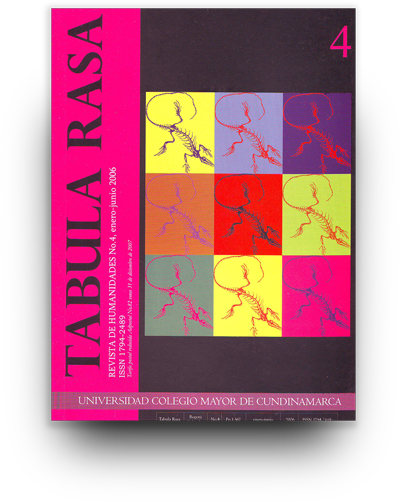Geography and the African Diaspora: an assessment
Una valoración de la geografía y la diáspora africana
Show authors biography
The study of the African diaspora has become a vibrant area of research and teaching in recent years across the disciplines. However, geographical contributions remain few. This article seeks to reverse that trend. Relevant work by geographers on the Black Atlantic is reviewed to identify promising themes for research. The dispersal of African plants, and the role of the enslaved in establishing them, holds particular promise. This research direction clarifies the African components of the Columbian Exchange while drawing attention to the importance of subsistence in the transatlantic slave trade and plantation economies. Foodstaples of African origin served subsistence as well as memory. African plants are featured prominently in diasporic foodways, the liturgical practices of Afrosyncretic religions, and in Maroon oral histories.
Article visits 129 | PDF visits 69
Downloads
Araújo dos Anjos, Rafael Sanzio. 2005. Territórios das Comunidades Quilombolas do Brasil.
Brasilia: Mapas Editora & Consultoria.
Barbot, Jean. 1752. «A Description of the Coasts of North and South Guinea; and of Ethiopia Inferior, vulgarly Angola; being a New and Accurate Account of the Western Maritime Countries of Africa» en Awnsham Churchill, A collection of voyages and travels, some now first printed from original manuscripts, others now first published in English, 8 vol. Londres: impreso de los señores Churchill, para T. Osborne.
Bebbington, A. 1991. «Indigenous agricultural knowledge systems, human interests, and critical analysis: Reflections on farmer organization in Ecuador» Agriculture and Human Values, 8:14-24.
Berleant-Schiller, R. y L. Pulsipher. 1986. «Subsistence Cultivation in the Caribbean» New West Indian Guide 60, nos. 1&2:1-40.
Butzer, Karl O. 2002. «French Wetland Agriculture in Atlantic Canada and Its European Roots: Different Avenues to Historical Diffusion» Annals of the Association of American Geographers, 92, 3: 451-470.
Butzer, K. (editor). 1992. «The Americas before and after 1492: Current Geographical Research» Annals, Association of American Geographers, 82, no. 3.
Buvelot, Quentin. (ed.). 2004. Albert Eckhout: A Dutch Artist in Brazil. La Haya: NIB Capital.
Carney, Judith A. 2005a. «Out of Africa: Colonial Rice History in the Black Atlantic»» en L. Schiebinger y C. Swan (eds.), Colonial Botany: Science, Commerce, and Politics in the Early Modern World. 204-220. Filadelfia: University of Pennsylvania Press.
Carney, Judith A. 2005b. «Rice and Memory in the Age of Enslavement: Atlantic Passages to Suriname» Slavery and Abolition, 26, no. 3:325-347.
Carney, Judith A. 2004. «”With Grains in Her Hair”: Rice History and Memory in Colonia Brazil» Slavery and Abolition, 25, no.1:1-27.
Carney, Judith A. 2003. «African Traditional Plant Knowledge in the Circum-Caribbean Region» Journal of Ethnobiology, 23, no.2:167-185.
Carney, Judith A. 2001. Black Rice: The African Origins of Rice Cultivation in the Americas. Cambridge, Mass.: Harvard University Press.
Carney, J.A. y R. Acevedo. 2003. «Plantas de la Diáspora Africana en la agricultura del Brasil Colonial» Memoria y Sociedad, 7, no. 15:9-23.
Carney, J. y R. Voeks. 2003. «Landscape Legacies of the African Diaspora in Brazil» Progress in Human Geography, 27, no. 2:139-152.
Carney, Judith A. y Peter Mark. 2002. «Portuguese» Style and Luso-African Identity. Bloomington: Indiana University Press.
Carney, Judith A. y Mario Hiraoka. 1997. «Raphia taedigera in the Amazon Estuary» Principes, 41, no. 3:125-130.
Crosby, Alfred W. 1986. Ecological Imperialism: The Biological Expansion of Europe, 900-1900. Nueva York: Cambridge University Press.
Crosby, Alfred W. 1972. The Columbian Exchange:Biological and Cultural Consequences of 1492. Westport, Connecticut: Greenwood Press.
Crow, Ben y Alan Thomas. 1983. Third World Atlas. Philadelphia: Open University Press.
Debret, J.B. 1954. Viagem Pitoresca e Histórica ao Brasil: 1834-1839. 2 vols. São Paulo: Livraria
.
Denevan, W. M. 1992. «The pristine myth: The landscape of the Americas in 1492» Annals, Association of American Geographers, 82:369-85.
Donkin, R.A. 1991. Meleagrides. An Historical and Ethnogeographical Study of The Guinea Fowl. Londres: Ethnographica.
Donkin, R.A. 1989. The Muscovy Duck: Carina moschata domestica: Origins, Dispersal, and Associated Aspects of the Geography of Domestication. Brookfield, Vermont: A.A. Balkema.
Donkin, R.A. 1985. The Peccary—With Observations on the Introduction of Pigs to the New World. Filadelfia: American Philosophical Society.
Doolittle, W.E. 1995. «Indigenous development of Mesoamerican irrigation» Geographical Review, 85:301-23.
Earle, Carville. 1992. Geographical Inquiry and American Historical Problems. Stanford: Stanford University Press.
Fonseca Fernandes da Cunha, Lygia da. 1960. Riscos illuminados de figurinhos de brancos e negros dos uzos de Rio de Janeiro e Serro do Frio, aquarelas Carlos Julião. Rio de Janeiro: Biblioteca Nacional.
Fredrich, Barbara E. 1976. Morphology of Dooryard Gardens: Patterns, Imprints, and Transformations in St. Lucia, West Indies, Disertación para Ph.D., Geografía, University of California, Los Angeles.
Galloway, J.H. 1989. The Sugar Cane Industry: An historical geography from its origins to 1914. Cambridge: Cambridge University Press.
Grimé, W.E. 1979. Ethno-botany of the Black Americans. Algonac, Mich.: Reference Publications.
Hecht, S. y D. Posey. 1989. «Preliminary results on soil management techniques of the Kayapó Indians» Advances in Economic Botany, 7:174-88.




